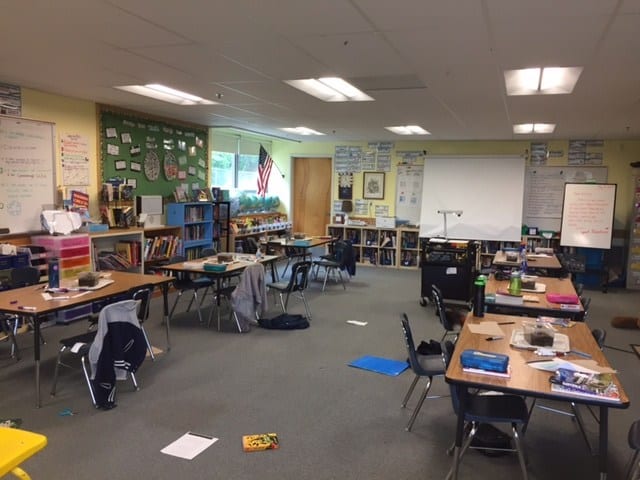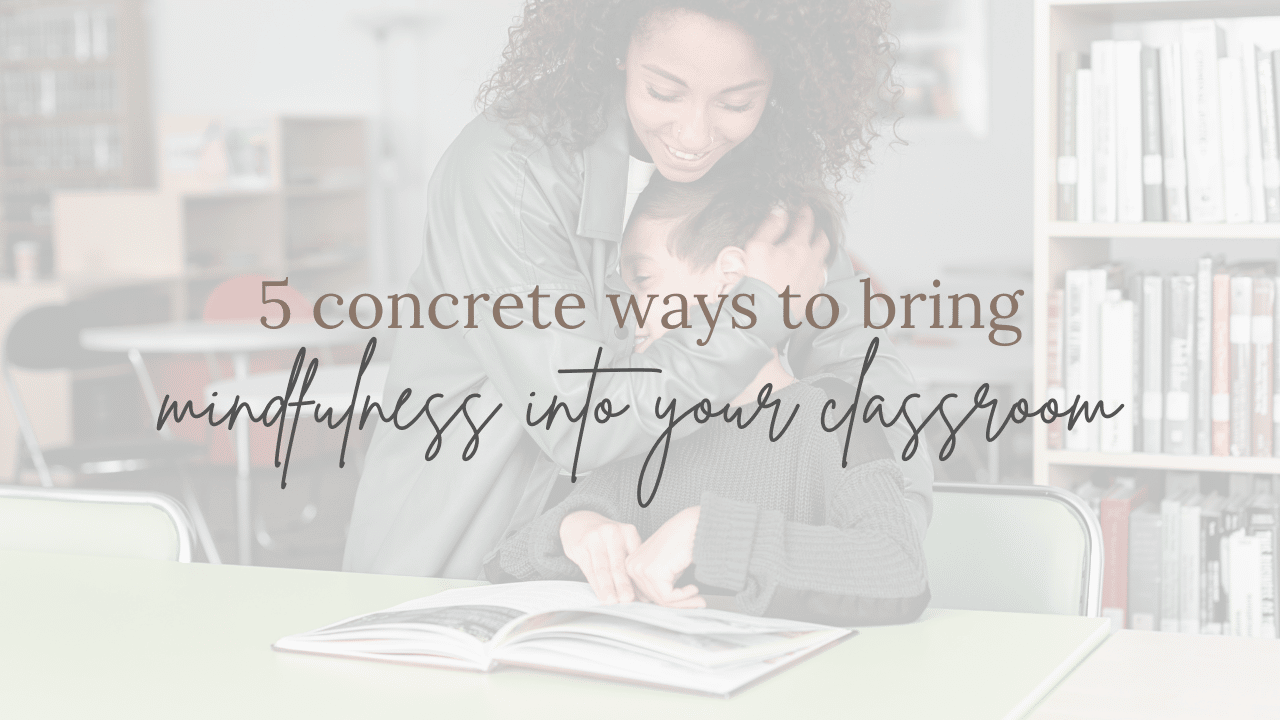5 Concrete Ways to Bring Mindfulness Into Your Classroom
Do you imagine a classroom where students follow directions? Where any issues that come up are managed and solved in a healthy, productive, and positive manner? Where you feel balanced, grounded, and calm? Where you and your students have healthy, supportive, and respectful relationships with each other? When your students “do the right thing” for the sake of “doing the right thing?” Where there’s a true sense of community, camaraderie, authenticity, vulnerability, individuality, and wholesomeness? Well, this isn’t just a figment of your imagination – this can be your reality by starting with these 5 simple tips.
No. 1
The physical space of your classroom environment
Have you ever heard of environmental psychology? If not, prepare to have your mind blown. The physical space around us has much more of an impact on our psychology, mentality, functionality, and productivity than you may think. An organized, clutter-free, distraction-free environment has been scientifically proven to yield the best, most positive impacts for key learning factors, such as mood, motivation, relationships, performance, time-management, and focus. Environmental psychology also considers more environmental factors, such as lighting and architecture. Now, how can we apply these points to a classroom environment?
As students and teachers, we spend at least 7-8 hours a day inside the classroom, or about ⅓ of each school day. There’s an average of 180 school days per year, so that means that we are spending roughly 1,350 hours per year inside of our classroom(s). And that’s not including before school, after school, summer school, etc. That’s a LOT of time. That amount of time can strongly affect our students and ourselves, as teachers. So, what can we do about this?
Consider the bare bones of your classroom, the architecture of your classroom. While this isn’t something that we, as teachers, can necessarily change, it’s important to take into consideration what you are working with. From there, you can plan accordingly. Personally, I like to use a neutral color palette and with natural elements (such as cotton, wood, tin, plants) and alternative, calming lighting (rather than those headache-inducing overhead fluorescent lights). Use this “Do-Don’t List” as a starting point for planning the physical space of your classroom. For further explanation of these points, check out my video here.

See below for my take on some different classroom set-ups.



While this classroom has a clear color palette and theme, I’d argue that this is way too cluttered. As a student, I wouldn’t know where to look or what is most important. This is why I’m a huge fan of rotating classroom posters or decor. We don’t have to keep everything up all of the time.
This classroom is a pretty accurate example of a typical, messy classroom. School and personal items are scattered around, there’s clutter everywhere, all of the storage items are random and mismatched. This classroom overall does not make me want to learn, let alone sit here for a class.
This classroom is a great example of an organized, clutter-free, distraction-free, calming, and productive classroom. It’s clear that everything has a home, and the addition of lamps and alternative lighting helps to give this classroom a homey and cozy atmosphere.
No. 2
Meet students where they are
As people, we each have our own “language,” or “communication style,” with our own preferences, body language, facial expressions, sense of humor, and so forth. But, as teachers, we need to modify our “language” to meet our students where they are. Or, to effectively meet the needs of our students. This means that we need to get to know our students at a deeper level, and discover who they are without placing judgment on them. Consider what’s going on in their lives, what they join, what they excel at, what they’re working on, and what they need support in. Use that to then tailor your communication. If you’re expecting students to meet expectations and complete their work and behave in a certain way, you need to, first, make these communication changes.
This isn’t about being fake or inauthentic to who you are. This is about teaching, and teaching is about your students. Think about the different people who you interact with on a regular basis – your parents, friends, colleagues, boss, neighbors, strangers, etc. You naturally show different parts of yourself when you’re interacting with each of these people, and you naturally hide different parts of yourself, too. This is the result of what’s appropriate for the interaction, situation, or individual(s) at hand. And, this concept applies to teaching, too.
Furthermore, just as we have our own filters, or perspectives, of life… our students do, too. And we not only need to see through those filters, but it would actually be incredibly helpful to try their filters on. To truly see and feel how life is from their shoes. Sometimes, it’s a matter of trying on your students “glasses” to see how they see the world.

No. 3
Create classroom structure and systems that are functional, and provide stability, security, and efficiency
Do your students know what to do when they enter your classroom? Or when they go into groups? Or when something unexpected happens? Or when they’re done with their work? Or when they need help? Or when they go home for the day?
Have you made these structures clear for the whole class? Have you repeated these structures to help them remember them? Have you provided your students with examples of what happens when we do or don’t adhere to the classroom structures? Have you created and posted visuals of said structures that are clearly visible from any seat in your classroom? Have you upheld these structures through the school day?
If you’ve done any of the above, you’re off to a great start! If you’ve not done any of the above yet, or if you want to do more of the above, it’s not too late! From my experience, structure can be created and upheld at any time and end up being quite successful. Keep reading and watch my YouTube video for some of my own experiences with this.
Structure and systems are what helps us meet our goals, and are what provides us all (students, teachers, parents, staff, and so on) with stability, security, and efficiency. We want to make sure our structure and systems are functional and have a clear purpose. We want to avoid creating structure and systems that are senseless or lack purpose. With the correct structure and systems in place, your classroom can easily transform into a calmer, and more mindful and aware learning environment.

And, here’s the thing. Students actually love structure. They thrive off of it. They rely on it – for their safety, wellbeing, consistency, progress, growth, success, guidance, and more. Students respect teachers with well-balanced, healthy, fair, and enforced systems and structure. Especially when it’s balanced with the more nurturing, compassionate, and supportive side of you.
I will specifically state that it is vital to balance structure and systems with compassion, nurturing qualities, and support. It’s vital to find, what I call, a “gentle strength.” That’s the secret sauce. That’s where the magic lies.
No. 4
How you say, what you say
Tying into number 2, meet students where they are, what you say and how you say it matters. Point blank. I’m not a fan of recreating the wheel when I don’t need to, so I’m going to share what one of my favorite supervisors recently shared with my school, with my twist and additions:
Say Less
Stress
Go Slow
Show
Simplify what you say.
Be concise.
Use short and clear sentences.
Avoid fluffy or long-winded language.
Identify and exaggerate keywords.
Stress the key words when you are speaking.
Use fun and student-friendly (and appropriate) language.
Pause between words and phrases.
Be natural.
Include purposeful deep breaths (this helps to slow your pace, reminds you to slow down, shows students that you are practicing mindfulness yourself, and students will eventually start to copy that as they often mimic what they see)
Most, if not all, students, children, and people are visual learners.
When possible, use and show real objects in class that connect to your lesson (and let students touch and interact with them, when appropriate).
Fine-tune your acting skills and exaggerate your own actions and gestures.
Utilize pictures, labels, printed words, and so on.
There is so much more to this section than I can put in a single blog post. Things like your tone, body language, energy, and more, are incredibly important when it comes to teaching. Click here to learn more about that!
No. 5
Continue to work on yourself
Unpopular opinion: As teachers continue to work on themselves and do their inner work, they find more balance, peace, harmony, and joy in teaching.
Furthermore, we are the mirror of our classroom. Every single thing we think, feel, say, don’t say, do, don’t do, believe, experience… all of our traumas (unprocessed, childhood, family, ancestral, etc.), unhealed parts of ourselves, our triggers, our values, our habits, our mindsets… every single thing that makes us who we are shows up in our classroom. It is vital that we take responsibility for this and continue to work on ourselves.

There are even more ways to bring mindfulness into your classroom. Check out this instagram post for 6 more tips. And check out my self-paced online course “An Introduction to the Mindful Classroom” to go deep into this topic and to help transform your classroom into the zen den of your dreams.



